
Verbs and Adverbs: 6 Interesting Familiar Types and More
Table of Contents
Verbs and adverbs are essential in the English sentence structure. They are crucial to the functioning of language.
Verbs are defined in the English dictionaries. Almost every sentence has a verb. They are used to describe actions. Verbs have various forms in the English language. Transitive and intransitive verbs are examples of verb forms. Also, there are different types of verbs. Some of these common forms are linking verbs and regular verbs.
Adverbs are also important to the meaning and the structure of the sentence in English. What is the definition of a verb? What is the purpose of an adverb in the sentence? Are there types of verbs? Do they come in a certain order in the sentence? Are they related to the verb? We will know all about verbs and adverbs here.

What is The Definition of a Verb?
A verb is a word like jump, think, love and feel, which is usually one of the basic parts of a sentence and that expresses an action, an occurrence, or a state of being. It is the basic word in the sentence. Sentences are not complete without the verb.
What Are The Types of Verbs?
There are 15 types of verbs in the English Language. Each type has a specific function. There are four common types. Also, there are less common types. Some of the most common types are linking verbs and helping verbs. Other less common types are lexical and delexical verbs.
Main Verbs
Main verbs are also called lexical verbs. They show the action or the state of being of the subject. They have meaning on their own. There are thousands of main verbs in the English language. Let’s check some examples:
a- Sarah watches T.V
b- John plays tennis.
c- I love pizza.
d- They jump high.
Linking Verbs
Linking verbs connects the subject to an idea of the predicate. So, they link between the subject and information about the subject. When they are used, they say what someone or something is. Verb ‘be’ functions as a linking verb. Other verbs can be used as linking verbs like, ‘look’ and ‘seem’
Let’s check the following examples:
- The kid is naughty.
- He seems sad.
- They look happy.
Helping Verbs
Helping verbs are also called auxiliary verbs. They don’t have a meaning on their own. They only help the main verbs to show the actions and express their full meaning. They add detail to the main verb and also clarify how time is conveyed.
There are three groups of helping verbs:
1- Primary helping verbs: be, do and have.
These verbs change form to match the subject. They function as helping verbs if they form the tense, ask a question, emphasize something or replace the main verb if it was already mentioned before. Let’s check some examples:
a- We are fishing. (form a tense)
b- Do you have enough money? (form a question)
c- I do love cats. (emphasize meaning)
d- He listens carefully more than she does. (replace a verb already mentioned before)
2- Modal Helping Verbs
They are used to change the meaning of the main verb. They express necessity or possibility. The following is a list of the modal verbs and some examples to show how they are used in the sentence:
| Can, could | I can’t speak French. |
| May, might | The teacher may arrive late. |
| Will, would | Would you like some juice? |
| Shall, should | You should study well. |
| Must, ought to | We must go now. |

3- Semi-Modal Helping Verbs
Need, dare and used to are semi-modal verbs. They function in the same way as modal verbs. They are like auxiliary verbs that add information to the main verb but can’t stand alone. They are somehow different from modal verbs as they change to agree with the subject and change tense. Let’s check some examples:
- We need to visit our grandparents.
- The students don’t dare come late to class.
- They used to watch cartoon movies before going to bed.
Transitive and Intransitive Verbs
They are considered as main verbs. Transitive verbs take a direct object while intransitive verbs don’t take a direct object to express a complete thought. Some verbs work as both transitive and intransitive. Let’s check the following examples:
- The kids visited the zoo. (transitive verb)
- We are watching T.V. (transitive verb)
- The baby is laughing. (intransitive verb)
- May I sit? (Intransitive)
- They played football. (transitive)
- They played outside. (intransitive)
Regular and Irregular Verbs
They are considered as main verbs. They are more related to vocabulary than grammar. The difference between them is the ending of each verb in the past tense and past participle form. The regular verbs end in -d, -ed, or -ied while the irregular ones have various endings according to the verb. Let’s check some examples:
Regular Verbs: Play, played, played, and Work, worked, worked
Irregular Verbs: Have had, had, and Go, went, gone
Dynamic and Stative Verbs
They are also considered as main verbs. Dynamic verbs usually describe an action and can be used in a continuous form. While stative verbs refer to a state or condition and can’t be used in the continuous form. They describe a state that lasts for some time. Here’s a list with some stative verbs:
- like
- love
- hate
- need
- want
- prefer
- agree
- mind
- sound
- hear
- own
- disagree
- satisfy
- doubt
- wish
- dislike
- deserve
- know
- realize
- mean
- support
- believe
- remember
- recognize
- appear
- taste
- promise
- please
- think
- be
- have
- see
- seem
Some verbs can function as both dynamic and stative. The verbs ‘be’, ‘think’, ‘have’, ‘see’ and ‘taste’ are examples of these verbs. Let’s check the following sentences:
- I think this pizza is delicious. (stative/opinion)
- I’m thinking about the next week’s exam. (dynamic)
Finite and Non-finite Verbs
Finite verbs change their form when there is a change in the number or the person of the subject. They also change the form when they change the tense of the sentence. Non-finite verbs don’t change their form when there is a change in the number of the subject or the tense of the sentence. Let’s see some examples:
- My little sister ‘wants’ to be a hostess. (finite)
- Your duty is ‘to study’ well. (Non-finite)
Delexical Verbs
Delexical verbs are action words when they are added to nouns they have a little meaning of their own. Some of these common verbs are ‘have’, ‘go’, ‘take’, ‘do’ ‘make’ and ‘give’. The meaning of the action is found more in the noun, not in the verb. Let’s look at some examples:
- I have breakfast at 8:00 am.
- You need to take a break.
- The principal will make her speech.
- Sue gave Sally a piece of advice.
- They go swimming at weekends.
- It’s his turn to do the laundry.
Modal Verbs
Modal verbs are used to express certainty, possibility, and impossibility, They are also used to talk about ability, to ask permissions, and to make requests and offers. They don’t change form when the number or the person of the subject changes. The modal verbs are:
- May
- Might
- Will
- Would
- Shall
- Should
- Can
- Could
- Must
Let’s look at the following sentences:
- Sue can’t swim
- May I ask a question?
- Can I have a tissue, please?
- Would you help me?
Phrasal Verbs
Phrasal verbs are very common in the English language and are made up of a verb and a particle or two particles. The particle always changes the meaning of the verb. Separable and inseparable are the two particles.
With separable particles, the verb and the particle can be apart or together. However, the and the verb have to be separated if we use a pronoun. With inseparable particles, the particle and the verb can’t be separated. Phrasal verbs with two particles are inseparable. Let’s look at some sentences:
- I’ll pick you up from school. (separable)
- You need to look after the baby. (inseparable)
- We are looking forward to the vacation. (two particles/inseparable)

What are the Different Forms of a Verb?
Verbs have different forms in the English language. There are five main forms. These forms make all the tenses and other verb structures, in all moods, aspects and voices. These forms are base form, present tense form, past tense form, present participle form and past participle form.
The base form is the same as the entry in the dictionary. It doesn’t have any endings. It doesn’t include any prefixes or suffixes. It can be used after the infinitive, modal auxiliary or verbs of seeing and hearing. It is also used to create other conjugated forms. Let’s check some examples:
- The kids play in the garden every evening.
- Men live in a fantasy world.
The present tense form of a verb is created when we use the present simple tense. We need to pay attention to the subject-verb agreement. The present tense form of the verb in the present simple tense with a singular subject has different endings according to the base form of the main verb. Let’s check the following:
This table shows the conjugation of the verb in the present tense form:
| Add -es to the base form | The base form ends in -s, -ss, -sh, -ch, -x, -o, -z | Ex: John watches T.V every night. |
| Add -it to the base form and cross out the y | The base form ends in Consonant+y | Ex: The baby always cries |
| Add -s to the base form | The base form doesn’t end in any of the above-mentioned cases | Ex: Miranda sings well. |
| Verb ‘Be’ | Irregular verb: Am is, are | Ex: – The door is red. – They are happy. – I’m so excited. |
| Verb ‘Have’ | Irregular verb: has, have | Ex: – Sue has a car. – We have a quiz. |
The past tense form of the verb is created when we form the past simple tense. The base form of the verb has different endings in the past simple tense. Many irregular verbs don’t follow any spelling rules. Let’s check the following table for the different conjugations of the verbs:
| Add -ed to the base form of the verb | The base form ends in -s, -ss, -sh, -ch, -x, -o, -z | Ex: She washed the dishes yesterday. |
| Add -it to the base form and cross the y | The base form ends in consonant+y | Ex: I carried all the books. |
| Add -d to the base form | The base form ends in -e | Ex: They tasted the food. |
| Double the consonant and add -ed | The one syllable base form ends in vowel + consonant | Ex: He cancelled the meeting. |
| Double the consonant and add -ed | The final syllable of the base form is stressed and ends in vowel + consonant. | Ex: he preferred to stay at home. |
Here is a list of some irregular verbs:
| Base Form | Past Tense Form |
| Be | Was, were |
| have | had |
| do | did |
| say | Said |
| pay | paid |
| cut | cut |
| put | put |
| teach | taught |
| tell | told |
| break | broke |
| take | took |
| sing | sang |
| run | ran |
| get | got |
| ring | rang |
The present participle form of a verb is used in the past, present, and future progressive verb tenses. They are often used as adjectives. They are sometimes used as adverbs. They can also be used as nouns. Certain participles can be used to describe the cause of the people’s feelings like ‘excited’ and ‘bored’.
The present participle form is created by adding -ing to the base form of the verb. There are some spelling rules to create the base form for some of the verbs. Here is a list of some verbs in the present participle form:
| Add -ing to the base form | Ex: The kid is doing his homework. | Present progressive |
| Double the consonant then add -ing( if the base form is one syllable, V + C) | Ex: Planning is a good skill. | Noun |
| Double the consonant and add -ing (if the final syllable of the base form is stressed, V + C) | Ex: They are unwrapping the box. | Present progressive |
| Cross the -e then add -ing | Ex: It is a boring movie. | Adjective |
The past participle form of the verb is used in the present perfect tense, past perfect tense, future perfect tense, third conditional, and the passive form or modals in the past tense. It is used to create the past tense form or as an adjective. There are regular and irregular verbs. Each one has some ways to create the form.
Here is a list of some regular and irregular verbs and the creation of the past participle form:
| Add -ed to the base form of the verb (if it ends in -s, -ss, -sh, -ch, -x, -o, -z) | Ex: They have watched the T.V | Present perfect |
| Add -it to the base form and cross the ‘y’ (if it ends in consonant+y) | Ex: I had carried the bags. | Past perfect |
| Add -d to the base form (if it ends in -e) | Ex: She feels bored. | Adjective |
| Double the consonant then add -ed (if the one syllable base verb ends in V+C) | Ex: We will have stopped the instalment by 2030. | Future perfect |
| Double the consonant then add -ed (if the final syllable of the base form is stressed and ends in V+C) | Ex: The meeting has been cancelled. | Passive form |
Here is a list of some of the irregular verbs in the past participle form:
| Base Form | Past Participle |
| is | been |
| do | done |
| have | had |
| go | gone |
| cut | cut |
| put | put |
| break | broken |
| sleep | slept |
| steal | stolen |
| catch | caught |
| leave | left |
| lay | laid |
| lie | lain |
What is The Grammatical Function of a Verb?
Each verb has a grammatical function in the sentence. There are six grammatical functions performed by the verb within the predicate. The verb can grammatically function as a predicate, passive, progressive, perfect, modal or operator. As a predicate, it expresses the action performed by or condition of the subject.
- My mother washed the dishes.
As a progressive, it expresses incomplete or ongoing actions or conditions at a specific time. Regarding the passive, it moves the object of an active sentence into the subject position. As for the perfect, it expresses the consequences resulting from a previous action or condition.
- Our neighbour has sold his house.
- The books got collected last week.
As for the modal, it expresses modality. Modality expresses possibility, necessity, and contingency. As for the operator, it facilitates the expression of negation, interrogatives, and emphasis. The auxiliary verb that functions as the operator is the verb do.
- You must wear a mask to get in.
- I did enjoy the show.

What is an Adverb?
An adverb is a word that describes a verb, an adjective, another adverb, or a sentence and that is often used to show time, manner, place, or degree.
It is a part of speech. Some adverbs modify a phrase or a clause or even a whole sentence. They are easy to find because most of them end in -ly.
What Are The Types of Adverbs?
There are various types of adverbs. Each type has a function in the sentence. Adverbs provide more information in a sentence by modifying another word. Here are the six common types of adverbs in the English language.
Adverbs of Time
Adverbs of time show the time or moment of doing a task. They include words that refer to specific times and more general periods. They change or add meaning to a sentence by telling us when, for how long, and how often a certain action happened.
Adverbs of time come after the verb and the object. In many cases, that’s at the end of the sentence. However, you can also put the adverb of time at the beginning of a sentence. Here is a list of adverbs of time:
| Function | Adverbs |
| points of time | Now, then, tomorrow, tonight, yesterday |
| Frequency (definite) | Annually, daily, weekly, yearly, monthly, quarterly, hourly, fortnightly, nightly |
| Frequency (indefinite) | Always, constantly, ever, frequently, generally, infrequently, never, normally Occasionally, often, rarely Regularly, seldom, sometimes Regularly, usually |
| relationships in time (indefinite) | Already, before, early, earlier Eventually, finally, first, formerly, just, last, late Later, later, next, previously Recently, since, soon, still, yet |
Here are some sentences that include adverbs of time in different positions in the sentences:
- I’m going for a walk now.
- They always wake up early.
- The students have already done their homework.
- He is still teaching.
Adverbs of Manner
Adverbs of manner tell us how something happens. They are usually placed either after the main verb or after the object. Just like other adverbs, they can provide more detail to sentences, giving the reader a clearer picture.
To make adverbs, we normally add ly to the adjective. Sometimes the spelling is different. Some adverbs don’t have ly. When an adjective ends in -y we change the -y to -I and then add -ly. Here is a list of adverbs:
| Regular Adverbs | Irregular Adverbs |
| Accidentally, angrily, anxiously Awkwardly, badly, beautifully Blindly, boldly, bravely, brightly Busily, calmly, carefully, closely Correctly, courageously, cruelly Daringly, deliberately, doubtfully Eagerly, easily, elegantly, enormously, enthusiastically Equally, eventually, exactly, faithfully | Well, hard, fast, high, late, straight, early, wrong |
Here are some sentences that include adverbs of manners:
- You speak English fluently.
- The children did well in their tests.
- I hate getting up late.
- It rained heavily all through the night.
Adverbs of Place
Adverbs of place indicate where an action occurs. Adverbs of place are normally placed after a sentence’s object or main verb. Adverbs of place can be directional. Here is a list of adverbs of place:
| Movement | Around, away, over, off, in, down, upstairs, downstairs, outside |
| Direction | Backwards, towards, upwards, east, west, back, behind, below, here, there, near, far, below, between, down, forward |
| Unspecific locations | Somewhere, anywhere, everywhere, nowhere, elsewhere |
Here are some example sentences of adverbs of place:
- Sarah lives behind the movie theatre.
- Put your card here, please.
- The builder is coming down the ladder.
- Be careful! The car is moving backwards.
Adverbs of Frequency
Adverbs of frequency are used to say how often we do things or how often things happen. They go before the main verb in a sentence. However, the exception is when the sentence contains the verb ‘to be’. In this case, it goes after the verb. Here is a list of adverbs of frequency:
| Adverbs of Frequency | Always, usually, often, sometimes, rarely, never, occasionally, seldom, hardly ever, rarely, never |
Here are some example sentences of adverbs of frequency:
- I often play tennis on Fridays.
- They usually go to work by car.
- She always wakes up late.
- We’ve never gone to the cinema.
Adverbs of Degree
Adverbs of degree help us to express ‘how much we do something. They can either intensify the meaning or make it weaker. They are usually placed before the adjective, adverb, or verb that they modify, although there are some exceptions. Here is a list of adverbs of degree:
| Adverbs of Degree | Almost, absolutely, awfully, badly, barely Completely, decidedly, deeply, enough Enormously, entirely, extremely, fairly Far, fully, greatly, hardly, highly, how Incredibly, indeed, intensely. Just, least Less, little, lots, most, much, nearly, perfectly, positively, practically, pretty Purely, quite, rather, really, scarcely Simply, so, somewhat, strongly, terribly Thoroughly, too, totally, utterly, very, virtually, well |
Conjunctive Adverbs
A conjunctive adverb is a word (or short phrase) that provides a link to the previous sentence or previous independent clause. They bring together two complete thoughts in conjunction. Here is a list of conjunctive adverbs:
| Conjunctive adverbs | Also, consequently, furthermore, however Incidentally, indeed, likewise, meanwhile Nevertheless, nonetheless, therefore |
Here are some example sentences of conjunctive adverbs:
- Chris enjoys making snow angels; also, he loves throwing snowballs.
- You are grounded for three weeks; furthermore, you cannot text anyone on your phone.
What is The Function of Adverbs in The Sentence?
Adverbs describe the way an action is happening. Also, the purpose of the adverb is to add a degree of intensity to the adjective. they can describe a general feeling about all of the information in the sentence.
Hence, verbs and adverbs play an essential role in sentence structure. Both have various functions in the sentence. They have different types. They can be placed in different positions in the sentence. They create the complete thought of the sentence.
Common Mistakes in Verb and Adverb Usage:
Understanding verbs and adverbs is crucial for clear and effective communication. However, even seasoned writers can make mistakes. Here are some common errors in verb and adverb usage, along with clear examples to help you avoid them:
Verb Errors:
- Subject-verb agreement: Ensure the verb agrees with the subject in number (singular/plural).
- Incorrect: The team was happy with their achievements. (Singular subject “team” needs singular verb “is”)
- Correct: The team is happy with their achievements.
- Tense consistency: Maintain consistent verb tense throughout a sentence or paragraph.
- Incorrect: She walked to the store yesterday and is buying groceries now. (Mixing past and present)
- Correct: She walked to the store yesterday and bought groceries then. (Consistent past tense)
- Confusing verbs with similar sounds: Use the correct verb based on meaning.
- Incorrect: He laid down the book carefully. (Laying implies placing something down permanently)
- Correct: He lay down the book carefully. (Lying refers to resting or reclining)
- Misusing helping verbs: Understand the function of “have,” “has,” and “had.”
- Incorrect: I have already eaten breakfast. (Past action, no need for “have”)
- Correct: I ate breakfast already.
Adverb Errors:
- Misplacing adverbs: Position adverbs to modify the intended word clearly.
- Incorrect: He talked loudly in the room. (Unclear if he talked loudly or was in the room loudly)
- Correct: He talked loudly in the room. (Modifies “talked”) or He talked in the room loudly. (Modifies “room”)
- Confusing adjectives and adverbs: Use the correct form depending on the function.
- Incorrect: She sang beautiful. (Adjective describes noun “she,” not verb “sang”)
- Correct: She sang beautifully. (Adverb modifies verb “sang”)
- Using double negatives: Avoid making a statement negative twice.
- Incorrect: I don’t have no money. (Double negative)
- Correct: I don’t have any money. (Single negative)
- Misusing adverbs of degree: Choose the appropriate adverb to convey the right intensity.
- Incorrect: He is very very happy. (Redundant)
- Correct: He is extremely happy. (Stronger word avoids repetition)
Remember:
- Practice good grammar habits regularly.
- Consult resources like dictionaries and grammar guides for clarity.
- Proofread your writing carefully to catch any errors.
Verbs and Adverbs FAQ
1. What are some other common verb and adverb mistakes I should avoid?
While this article covers several frequent errors, you can find more extensive lists online or in grammar guides. Common areas to watch out for include verb tense consistency in mixed tenses, subject-verb agreement with collective nouns, and using the correct helping verbs with irregular verbs.
2. How can I improve my understanding of verb and adverb usage?
Reading widely exposes you to diverse sentence structures and proper verb/adverb usage. Additionally, grammar practice exercises, online quizzes, and consulting reference materials like dictionaries and style guides can solidify your understanding.
3. Are there any online resources to help me with grammar skills?
Numerous websites and online platforms offer free grammar lessons, interactive exercises, and writing tools. Websites like Khan Academy, Grammarly, and Purdue Online Writing Lab (OWL) are valuable resources for learners of all levels.
4. Are there any tools or tricks to remember verb conjugations or adverb forms?
Mnemonic devices, flashcards, and visual aids can help you memorize verb conjugations and adverb forms. There are also online applications and games specifically designed to make grammar learning more engaging and interactive.
5. I still struggle with grammar. What should I do?
Don’t be discouraged! Learning grammar takes time and practice. If you’re facing specific challenges, consider seeking help from a tutor, joining a writing workshop, or enrolling in a grammar course. Remember, consistent effort and a positive attitude are key to mastering grammar skills.
Verbs and Adverbs Conclusion
Understanding verbs and adverbs empowers you to express yourself clearly and effectively in writing and speech. By learning from common mistakes, utilizing available resources, and practicing regularly, you can confidently navigate the world of grammar and wield verbs and adverbs with precision. Remember, clear communication is a valuable skill, and your dedication to improving your grammar will enhance your expression and understanding in all aspects of life.
Why not subscribe to our LearningMole Library for as little as £1.99 per month to access over 1200 fun educational videos.


Leave a Reply